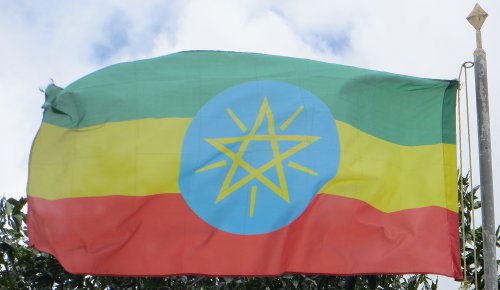Unique Ethiopia

Our days in Ethiopia were full of unique experiences that left an unforgettable footprint in our minds. From every angle we saw, we discovered a country with their own particular way of living and a proud community devoted to making their culture prevail. From their cuisine, language, traditional dances, music, ancient religion, calendar, and time system Ethiopia is one of a kind!
Ethiopian cuisine is exquisite and one of our favorites on earth. We found cafes in every corner and became fans of their thick tasty juices of mango, avocado, guava, papaya, and pineapple always enhanced with a refreshing squeezed lime. We found the best cafe in Gonder where all these fruit juices are served in a single glass, each one laying on top of the other one like a beautiful rainbow. The presentation and flavors of this multi-fruit juice was simply addicting, we lost count of how many of them we had.


We were in the country during the fasting days of Easter and we loved eating bayenat with our hands. Bayenet is a fasting dish of colorful vegetarian dishes served on top of injera to eat communal style. Injera is a popular pancake considered the national bread, which is thin, flat, and spongy. Injera is made of teff, an endemic cereal only cropped and consumed in Ethiopia that is more nutritious in iron and calcium content than wheat. Finishing our meal with a delicious tea or coffee was always a plus, even Sal who is not a coffee drinker was delighted by it. Coffee plants are also endemic to Ethiopia and they grow wild in the forest. Drinking coffee is a ceremony and a very special tradition that we enjoyed all over the territory.
During our days in Lalibela, we took a 2-hour cooking class at a 16-year-old family restaurant owned by Sisco, a hard working mother that one of her many goals is giving her 5 children access to higher education. At her traditional firewood kitchen, we were thought by her teenage daughters Tihitina and Tigisit, the art of making injera and the vegetarian dishes for the bayenet. The class was so much fun, we could not stop laughing at the difficulty we had to make injera and pronounce the names of the dishes in Amharic, their national language. Tihitina and Tigisit speak english very well and they showed us step by step the different stages of making injera: from the 3-day teff fermentation to the opportunity and technique of pouring the batter mix over the clay pan. We learned the recipes of the different fasting dishes, which are made mainly with onions, beets, potatoes, cabbage, garlic, chickpeas, carrots, spinach, salt, turmeric, vegetable oil, water, and of course berbere, a mix of sun dried spices that is a signature of Ethiopian cuisine. At the end of our class we ate our creation, the most abundant and delicious bayenet we had during the entire stay in the country. Tigisit dressed in traditional clothing tried teaching us some of the azmari shoulder moves, their traditional dance. She also performed a coffee ceremony for us, which is a special and detailed process of cleaning, roasting, grinding, boiling, serving, and drinking coffee while enjoying the delicate smells of incense.

In Lalibela, we also visited their ancient Orthodox churches carved in rock. This group of churches, dating from the 12th and 13th centuries, is not only a World Heritage Site but a truly wonder of the world. We were mesmerized once again by the power that beliefs have over human behavior as they promote the creation of these magnificence structures. The Saint Giyorgis Church with its unique cross shape rising from the ground was our favorite. Even though we are not religious, we could not deny the sublime feeling of this sacred place. In Lalibela and in many other towns of Ethiopia, we were witnesses of massive congregations of believers dressing in white to attend the Orthodox temples. In Ethiopia, the arrival of Christianity dates back to the 4th century A.D. The Orthodox Christians believe in the full divinity and the true humanity of Jesus Christ. Angels and saints are venerated, as it is believed that God sends them to save the faithful from evil, and to help them in times of affliction. The blessed Virgin Mary is honored above all the saints. The believer is duty bound to observe a required fasting calendar, every Wednesday and Friday are fasting days, except during the 50-day-period right after Lent. A period of 55 days of fasting takes place before Easter and the discipline with which it is followed is simply unbelievable. The total number of fasting days is about 250 a year, of which 180 are obligatory for all people. Fasting generally implies one meal a day with a total abstention from meat, fat, eggs, and milk. Furthermore believers are expected to undergo a rigorous schedule of prayers and penitence. We were fortunate to be in the country during the Eastern celebration. The festive sentiment of this day was broadly expressed by people of all ages, dressing for the occasion and getting together with their relatives to enjoy meat in commemoration of Jesus’ resurrection. If Ethiopian fasting food was good, the meat just made it better, we tasted heaven 🙂

Ethiopian’s alphabet, time system, and calendar are also unique. Our visit to this nation was literally a trip back in time, the year was 2006 and not 2014. The country is proud of having “13 months of sunshine,” 12 months of 30 days and a last month of only 6 days. Time counting starts with the sunrise, 6 am in international time equals 0:00 in Ethiopian time. The daytime is counted from 0:00 to 12:00, through the 12 hours of sunlight, and the nighttime from 12:00 to 24:00. We were frequently confused by Ethiopian clocks, knowing the exact time we needed to be somewhere demanded a lot of thought. We admired the way in which Ethiopia has been able to maintain its own systems: language, calendar, and time. Ethiopians continue living life in their own terms without succumbing to external influences.
In Addis Ababa and Gonder, we attended azmari bets at night. An azmari bet is a bar where traditional music and dancing is performed. These places are decorated with traditional ornaments and the unique tej, Ethiopian honey wine, is served on elegantly shape glasses. We loved the euphoria of these evenings, the shoulder and head movements of the dancers are incredible. Although the lyrics of their songs were incomprehensible to us, the rhythm of the instruments and deep voices of the singers moved us. From those nights, we only regret not taking videos or pictures of this unique celebration, but here is a sample of their performance we found online so you can see as well. The enjoyment of the locals was captivating, regardless of the age, everybody was feeling the azmari. The strength of the Ethiopian culture is being planted on the younger generations, who dance and sing with a great sense of pride.

We left Ethiopia invaded by the nostalgia because we will miss their cuisine and culture beyond words. Although globalization is pushing the entire world to assimilate and change, Ethiopia’s reality became our consolation. This nation is one of those countries where tradition is winning the battle. Even as change appears inevitable over time, with the same pride in which this African nation defied colonialism and stayed independent, their people continue striving to live in their very own way.
